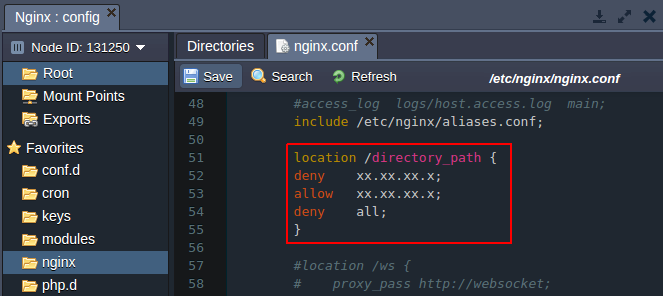Nginx Security Configurations
In this tutorial we will show how to set up the additional security configurations for your PHP application hosted with NGINX application server.
You can use the following types of security configurations:
A. Security through authentication
To provide this, come through the next steps:
-
Generate hash from your password. For that you can use any htpasswd tool or online service (for example, http://www.htpasswdgenerator.net/).
-
Create simple text file with previously generated hash.
-
Click Config button for your server.
-
Upload the created file to the /var/www/webroot/ROOT directory.

-
In the /etc/nginx directory, open nginx.conf file and modify directory configurations:
- authentication for the whole application Modify the location configurations by adding the following strings:
auth_basic “Restricted area”;
auth_basic_user_file /var/www/webroot/ROOT/.htpasswd;

- authentication for the separate directory
Add the following location strings stating the path to the required directory:
location ~ /directory_path {
auth_basic “Restricted”;
auth_basic_user_file /var/www/webroot/ROOT/.htpasswd;
}

- Save the changes and restart NGINX
As a result, while accessing the application or the protected directory a user will be requested to authenticate.
B. Security through setting up criteria
You can provide security for your application through setting up different criteria, for example, allow or deny access by IP address.
-
The Allow and Deny directives are used to specify which clients are or are not allowed access to the server. The rules are checked in sequence until the first match is found.
-
Open nginx.conf file in the /etc/nginx directory and add necessary directives:
- deny access to the whole application Modify the location configurations using the strings of the following type:
deny xx.xx.xx.x;
allow xx.xx.xx.x;
deny all;

- deny access to the separate directory
Add the following location strings stating the path to the needed directory:
location /directory_path {
deny xx.xx.xx.x;
allow xx.xx.xx.x;
deny all;
}

As a result, a user with any IP except of the allowed ones will see the 403 error while trying to open your application.
Note:
- Denying access through IP makes sense only if you use Public IP feature.
- Both criteria access restrictions and password-based authentication may be implemented simultaneously. In that case, the Satisfy directive is used to determine how the two sets of restrictions interact. More information you can get here.